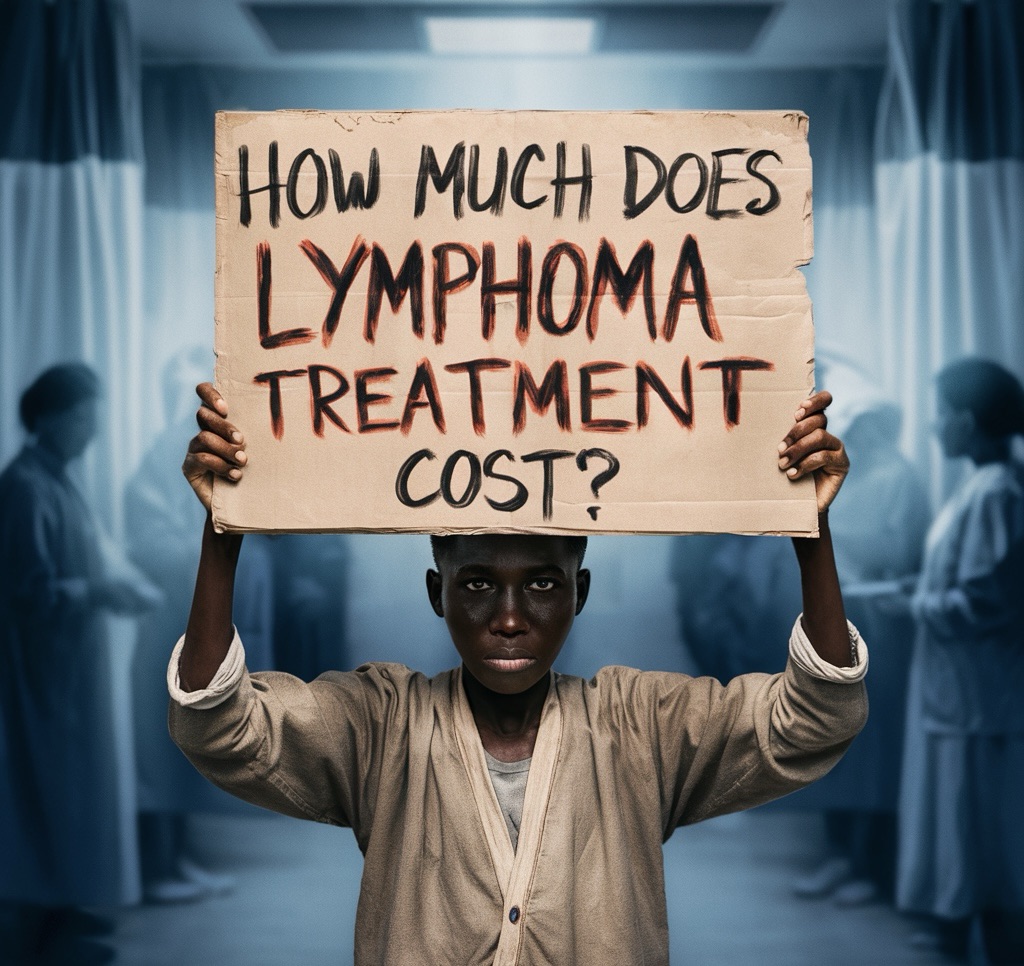The Financial Burden of Lymphoma Treatment
When faced with a lymphoma diagnosis, the emotional impact can be overwhelming. But beyond the initial shock and fear, another significant concern quickly comes into focus: the cost of treatment. Understanding how much lymphoma treatment costs is a crucial step in preparing for the journey ahead, as the financial burden can be substantial and complex.
Lymphoma, like many other cancers, often requires a combination of treatments, including chemotherapy, radiation, and potentially newer therapies like immunotherapy. The costs associated with these treatments can vary widely based on several factors, including the type of lymphoma, the treatment plan prescribed, the healthcare provider, and even your geographic location. For many, navigating these costs while also focusing on health and recovery can feel like an impossible task.

Beyond the direct costs of medical care, there are also indirect expenses to consider, such as transportation, time off work, and the emotional toll on both the patient and their family. It’s not uncommon for families to face significant financial stress during this time, making it even more important to have a clear understanding of the potential costs and the resources available to help manage them.
In this article, we’ll break down the key factors that influence the cost of lymphoma treatment, explore the typical expenses associated with different types of therapy, and offer practical tips on how to manage these costs effectively. We’ll also touch on the cost of chemotherapy for dogs with lymphoma, as pet owners often face similar financial decisions when their beloved animals are diagnosed with this disease.
Whether you’re just starting this journey or are in the midst of treatment, understanding the financial landscape is essential. With the right information and support, it’s possible to navigate these challenges and focus on what truly matters—your health and well-being.

What Factors Influence the Cost of Lymphoma Treatment?
Understanding how much lymphoma treatment costs involves looking at several key factors that can significantly affect the overall expense. These factors can vary from person to person, making it essential to consider your specific situation when estimating potential costs. Here’s a closer look at what influences the cost of lymphoma treatment:
1. Type of Lymphoma:
The type of lymphoma you’re diagnosed with—whether it’s Hodgkin’s lymphoma, Non-Hodgkin’s lymphoma, or a rarer form—can greatly influence the treatment plan and, consequently, the cost. Hodgkin’s lymphoma, for example, often has a well-defined treatment protocol, which might be less variable in cost compared to some forms of Non-Hodgkin’s lymphoma that may require more personalized or experimental therapies.
2. Treatment Plan:
The specific treatments prescribed by your oncologist will be one of the most significant determinants of cost. Common treatments for lymphoma include chemotherapy, radiation therapy, immunotherapy, and sometimes stem cell transplants. Each of these treatments comes with its own set of costs, which can vary based on the frequency of treatment, the duration, and the specific drugs or technologies used. For example, newer treatments like immunotherapy can be particularly expensive, but they may offer benefits that are worth the additional cost.
3. Location and Healthcare Provider:
Where you receive your treatment plays a big role in the cost. Treatment at a major cancer center in a large city might be more expensive than in a smaller clinic or hospital in a rural area. Additionally, the specific healthcare provider you choose can also affect costs—specialists and high-demand oncologists often charge more for their services, but they may offer expertise that is crucial for your treatment.
4. Insurance Coverage:
Your insurance plan will greatly impact how much you end up paying out-of-pocket for lymphoma treatment. It’s important to understand what your plan covers, including the percentage of treatment costs, deductibles, co-pays, and any out-of-network charges. In some cases, certain treatments may require pre-authorization from your insurance company, which can affect your ability to access certain therapies promptly. The financial burden can be substantial if your insurance does not cover experimental treatments or if you have a high deductible plan.
5. Indirect Costs:
In addition to the direct costs of treatment, there are indirect costs that can add up quickly. These include transportation to and from treatment centers, lodging if you’re traveling far from home for care, lost wages from time off work, and the emotional and psychological toll on both you and your family. Managing these costs requires careful planning and, in some cases, financial assistance from organizations that support cancer patients.
Alternative Approaches:
While conventional treatments are the most well-documented and widely used, some patients explore alternative or complementary approaches to reduce their overall costs or enhance their well-being during treatment. These can include natural remedies, dietary supplements, and holistic therapies. For example, exploring Natural Cures for Lymphoma might offer insights into additional support options that could complement your treatment plan, though it’s important to approach these alternatives with caution and in consultation with your healthcare provider.
Understanding these factors can help you prepare for the financial aspects of lymphoma treatment and make informed decisions about your care. In the next section, we’ll dive deeper into the specific costs associated with common lymphoma treatments, giving you a clearer picture of what to expect.

Breaking Down the Costs: Common Treatments for Lymphoma
When facing a lymphoma diagnosis, it’s crucial to understand the costs associated with different treatment options. The financial implications of treatment can vary widely depending on the type and duration of therapy. Here’s a closer look at the typical costs of the most common lymphoma treatments:
1. Chemotherapy Costs: Chemotherapy is one of the most common treatments for lymphoma, involving the use of powerful drugs to target and kill cancer cells. The cost of chemotherapy can vary based on several factors, including the specific drugs used, the number of cycles needed, and whether the treatment is administered in a hospital, clinic, or at home.
- For Humans: Chemotherapy can be expensive, often ranging from $10,000 to $200,000 per year, depending on the type and stage of lymphoma. The cost also depends on the specific regimen prescribed, as some newer chemotherapy drugs can be more costly than older ones. In addition to the cost of the drugs themselves, there are also costs associated with the administration of the treatment, such as facility fees, lab tests, and follow-up visits.
- For Pets: The cost of chemotherapy for dogs with lymphoma is another significant concern for pet owners. Treating a dog with chemotherapy can range from $3,000 to $10,000 or more, depending on the treatment protocol and the dog’s response. Pet insurance may cover some of these costs, but not all plans include coverage for cancer treatments, making it essential to review your policy or consider additional financial support options.
2. Radiation Therapy Costs: Radiation therapy uses high-energy rays to target and destroy cancer cells. It’s often used in conjunction with chemotherapy to increase the effectiveness of treatment. The cost of radiation therapy can also vary depending on the number of sessions required and the type of radiation used.
- For Humans: On average, the cost of a complete course of radiation therapy can range from $10,000 to $50,000. This cost includes the planning and simulation sessions, as well as the daily treatments over several weeks. The complexity of the radiation therapy—such as intensity-modulated radiation therapy (IMRT) or proton therapy—can also impact the cost.
3. Immunotherapy Costs: Immunotherapy is a newer form of treatment that harnesses the body’s immune system to fight cancer. While promising, immunotherapy can be one of the more expensive treatment options.
- For Humans: Immunotherapy drugs like checkpoint inhibitors or CAR T-cell therapy can cost between $150,000 and $500,000 per year, depending on the specific treatment and duration. These costs are often higher because immunotherapy is typically administered in specialized centers and involves complex, personalized care.
4. Stem Cell Transplant Costs: For some patients with lymphoma, a stem cell transplant may be recommended, especially in cases of relapse or when the lymphoma is particularly aggressive.
- For Humans: The cost of a stem cell transplant can be staggering, often exceeding $200,000. This includes the cost of the transplant itself, as well as the necessary pre-transplant conditioning (such as high-dose chemotherapy), hospitalization, and post-transplant care.
Additional Considerations: It’s important to remember that the costs outlined above do not include indirect expenses such as travel, lodging, lost income, and the need for ongoing supportive care. These additional costs can significantly increase the financial burden of lymphoma treatment.
As you navigate these costs, exploring complementary approaches to support your treatment can also be beneficial. For instance, some patients look into natural remedies, like those discussed in Ginger Oil Benefits, to help manage symptoms or improve overall well-being during treatment. While these alternatives should not replace conventional treatments, they may offer additional support.
Understanding the costs associated with lymphoma treatment is crucial for planning and ensuring that you have access to the best possible care. In the next section, we’ll explore the specific costs related to treating dogs with lymphoma, which is another important consideration for pet owners facing this diagnosis.

How Much Does Chemotherapy Cost for Dogs with Lymphoma?
Lymphoma doesn’t just affect humans; it’s also one of the most common cancers in dogs. When your pet is diagnosed with lymphoma, you’re not only faced with the emotional challenge but also the financial burden of treatment. Understanding how much chemotherapy costs for dogs with lymphoma is essential for making informed decisions about your pet’s care.
1. Veterinary Consultation and Diagnosis: Before treatment begins, the initial costs often include a veterinary consultation and diagnostic tests to confirm the lymphoma diagnosis. These costs can range from $500 to $1,500, depending on the tests needed, such as blood work, x-rays, and biopsies. These tests are crucial for determining the stage of lymphoma and developing an appropriate treatment plan.
2. Chemotherapy Sessions: Chemotherapy is the most common treatment for dogs with lymphoma. The cost of chemotherapy can vary significantly based on several factors, including the type of chemotherapy drugs used, the frequency of treatment, and the veterinary clinic’s pricing.
- Cost of Treatment: The total cost of chemotherapy for dogs typically ranges from $3,000 to $10,000. This cost includes the medication, administration, and necessary follow-up visits. The specific chemotherapy protocol, such as the CHOP (Cyclophosphamide, Hydroxydaunorubicin, Oncovin, and Prednisone) protocol, often used to treat canine lymphoma, can impact the overall cost. Additionally, newer and more effective chemotherapy drugs may be more expensive.
- Frequency and Duration: Dogs usually undergo multiple chemotherapy sessions over several weeks or months. The cost per session can range from $200 to $1,000, depending on the drug used and the veterinary clinic’s fees. Most protocols require weekly or bi-weekly sessions, adding to the cumulative cost.
3. Additional Costs: In addition to the direct costs of chemotherapy, there are other expenses to consider:
- Supportive Care: Dogs undergoing chemotherapy may require supportive care, such as anti-nausea medications, antibiotics to prevent infections, and regular monitoring of blood work. These additional costs can add several hundred dollars to the overall treatment cost.
- Follow-up Visits: Regular follow-up visits are essential to monitor your dog’s response to treatment and to manage any side effects. These visits typically range from $50 to $200 each, depending on the complexity of the care required.
4. Alternative Treatments: Some pet owners may explore alternative or complementary treatments to help manage their dog’s lymphoma, similar to what humans might consider. These can include natural supplements, dietary changes, or holistic therapies. However, it’s important to approach these alternatives with caution and always consult with your veterinarian before introducing any new treatments.
5. Pet Insurance: If you have pet insurance, it’s worth reviewing your policy to see what is covered. Some pet insurance plans may cover part or all of the costs associated with chemotherapy for lymphoma, but coverage varies widely. If you don’t have pet insurance, it’s important to consider the financial commitment required and explore other options for financial assistance if needed.
While the cost of chemotherapy for dogs with lymphoma can be significant, many pet owners find that the investment is worth it to give their beloved pets more quality time. However, it’s essential to weigh the benefits and financial implications carefully. Keeping your dog hydrated during treatment is also crucial, and resources like Hydration Powder Packets can be helpful in maintaining your pet’s overall health.
Understanding the costs and options available for treating lymphoma in dogs allows you to make the best decisions for your pet’s health and well-being. In the next section, we’ll explore strategies for managing these costs, including insurance options and financial planning.

Managing the Costs: Insurance, Assistance Programs, and Financial Planning
The financial burden of lymphoma treatment, whether for humans or pets, can be overwhelming. However, there are strategies and resources available to help manage these costs. Understanding your options and planning ahead can make a significant difference in navigating this challenging time. Here’s how you can manage the costs associated with lymphoma treatment:
1. Maximizing Insurance Coverage: Insurance plays a crucial role in reducing out-of-pocket expenses for lymphoma treatment. Whether dealing with human health insurance or pet insurance, it’s important to understand the details of your policy.
- Human Health Insurance: Review your health insurance policy carefully to understand what is covered, including chemotherapy, radiation therapy, immunotherapy, and any other treatments your doctor recommends. Check for:
- Deductibles and Co-Pays: Be aware of your deductible and co-pay amounts, which can add up quickly, especially with ongoing treatments.
- Out-of-Network Costs: Ensure your treatment is with in-network providers to avoid additional out-of-pocket expenses.
- Pre-Authorization Requirements: Some treatments may require pre-authorization from your insurance company. Make sure these are handled promptly to avoid delays in care.
- Pet Insurance: If you have pet insurance, check your policy for coverage related to cancer treatments. Some plans cover chemotherapy and other cancer-related expenses, while others may not. Understanding your policy’s limits and exclusions is key to minimizing unexpected costs.
2. Financial Assistance Programs: Several organizations offer financial assistance to cancer patients who are struggling to afford treatment. These programs can help cover the cost of medications, travel, lodging, and other treatment-related expenses.
- Nonprofit Organizations: Groups like The Leukemia & Lymphoma Society (LLS) and CancerCare provide financial assistance and grants to help cover treatment costs. These resources can be invaluable in managing the financial burden of lymphoma.
- Patient Assistance Programs: Many pharmaceutical companies offer patient assistance programs that provide medications at reduced costs or even for free, depending on your income level and insurance coverage.
3. Budgeting and Financial Planning: Effective budgeting and financial planning are essential when dealing with the high costs of lymphoma treatment. Here are some strategies to consider:
- Create a Treatment Budget: Work with your healthcare provider to get a detailed estimate of your treatment costs. This should include direct costs like chemotherapy and radiation, as well as indirect costs such as transportation, lodging, and lost income. Use this estimate to create a comprehensive budget.
- Explore Payment Plans: Many hospitals and treatment centers offer payment plans that allow you to spread the cost of treatment over time. This can make managing large medical bills more feasible.
- Consider Using Savings or Investments: In some cases, it may be necessary to dip into savings or liquidate investments to cover treatment costs. For those looking to optimize their financial resources, learning about investment strategies can be beneficial. Resources like the Robinhood Investment Guide offer insights into how to make your money work for you during difficult times.
4. Long-Term Financial Planning: Lymphoma treatment can be a long-term financial commitment. Planning for the future is essential to ensure that you can sustain treatment over time without depleting all of your resources.
- Seek Professional Advice: Working with a financial planner who specializes in medical expenses can help you navigate the complexities of paying for cancer treatment. They can help you develop a long-term plan that includes managing debt, protecting your assets, and planning for any potential future expenses.
- Explore Investment Strategies: Consider how strategic investments might help you manage or offset the costs of treatment. Articles like Why the Rich Stay Rich discuss how thoughtful financial planning and investment strategies can make a significant difference in maintaining financial stability during challenging times.
By taking proactive steps to manage the costs of lymphoma treatment, you can reduce financial stress and focus more on your health and recovery. Whether through insurance, assistance programs, or careful financial planning, there are resources available to help you navigate this difficult journey.

Balancing Health and Financial Well-Being
Navigating the costs of lymphoma treatment can be as daunting as the diagnosis itself. Understanding how much lymphoma treatment costs is essential for preparing both financially and emotionally for the road ahead. While the expenses can be significant, knowing your options and planning carefully can make this journey more manageable.
From the type of treatment you receive to the role of insurance and financial assistance, many factors influence the overall cost. Chemotherapy, radiation, immunotherapy, and stem cell transplants each come with their own set of expenses, and for pet owners, the cost of chemotherapy for dogs with lymphoma is another important consideration. Managing these costs requires a multifaceted approach that includes maximizing insurance benefits, exploring financial assistance programs, and creating a solid financial plan.
It’s also important to consider complementary approaches that might support your treatment and overall well-being. While natural remedies and holistic therapies, like those discussed in Natural Cures for Lymphoma, can provide additional support, they should be viewed as part of a broader, integrated treatment plan rather than a standalone solution.

By balancing your health needs with smart financial planning, you can reduce the stress of treatment costs and focus on what truly matters—your recovery and well-being. Remember, you don’t have to navigate this journey alone. With the right resources, support from healthcare providers, and careful planning, you can manage the financial impact of lymphoma treatment while maintaining hope and optimism for the future.
This concludes the article. It’s designed to provide a comprehensive overview of the costs associated with lymphoma treatment while offering practical strategies for managing these expenses. Let me know if you need any further adjustments or additional content!
As an Amazon Associate we earn from qualifying purchases through some links in our articles.




